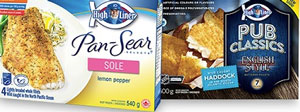 Rod HepponstallWhile posting another downturn in quarterly results, Lunenburg, Nova Scotia, Canada-headquartered High Liner Foods President and CEO Rod Hepponstall expects that North America’s biggest value-added frozen seafood company will return to a profitable pattern by 2020. In addition to High Liner, the manufacturing and marketing organization’s portfolio of retail and foodservice brands includes Fisher Boy, Mirabel, Sea Cuisine and C. Wirthy & Co., FPI and Icelandic Seafood.
Rod HepponstallWhile posting another downturn in quarterly results, Lunenburg, Nova Scotia, Canada-headquartered High Liner Foods President and CEO Rod Hepponstall expects that North America’s biggest value-added frozen seafood company will return to a profitable pattern by 2020. In addition to High Liner, the manufacturing and marketing organization’s portfolio of retail and foodservice brands includes Fisher Boy, Mirabel, Sea Cuisine and C. Wirthy & Co., FPI and Icelandic Seafood.
Sales in the fourth quarter of 2018 ending on December 29 decreased by $20.1 million to $242.9 million compared to $263.0 million in the same period in 2017. This was primarily due to decreased volume and changes in product mix, partially offset by price increases related to raw material cost increases.
 Gross profit in the fourth quarter of 2018 fell by $4.2 million to $40.3 million compared to $44.5 million in the same period during 2017, partially reflecting a decrease in gross profit as a percentage of sales to 16.6% compared to 16.9%. Gross profit in Q4 2017 included losses associated with a product recall that cost $1.5 million.
Gross profit in the fourth quarter of 2018 fell by $4.2 million to $40.3 million compared to $44.5 million in the same period during 2017, partially reflecting a decrease in gross profit as a percentage of sales to 16.6% compared to 16.9%. Gross profit in Q4 2017 included losses associated with a product recall that cost $1.5 million.
Excluding the impact of the recall, gross profit decreased by $5.7 million to $40.3 million (16.6% as a percentage of sales) compared to $46.0 million (17.5% as a percentage of sales) in the same period of 2017 due to lower sales volume, raw material cost increases, changes in product mix and US plant inefficiencies, partially offset by price increases. In addition, the weaker Canadian dollar had the effect of decreasing the value of reported US dollar gross profit from Canadian operations in 2018 by approximately $400,000 million relative to the conversion impact last year.
 For the 52-weeek period sales decreased by $5.3 million to $1,048.5 million. Gross profit, however, increased by $2.1 million to $188.2 million. Adjusted EBITDA decreased by $3.6 million to $62.5 million compared to $66.1 million, and net income decreased by $14.9 million to $16.8 million.
For the 52-weeek period sales decreased by $5.3 million to $1,048.5 million. Gross profit, however, increased by $2.1 million to $188.2 million. Adjusted EBITDA decreased by $3.6 million to $62.5 million compared to $66.1 million, and net income decreased by $14.9 million to $16.8 million.
“Our fourth quarter and year-end financial performance is aligned with expectations for this stage of our turnaround plan,” said Hepponstall. “With our successful organizational realignment behind us, our team is now positioned to unlock High Liner’s potential and deliver on our remaining critical initiatives. While there is still work to do and headwinds to contend with, we are seeing progress related to our ability to operate more efficiently and maximize opportunities on both sides of the border as one integrated North American organization.”
 Over the next nine to twelve months High Liner will concentrate on five critical initiatives aimed at stabilizing its business and creating optimal conditions for innovation, industry leadership and growth in support of long-term value creation for stakeholders. The company is currently focused on executing its critical initiatives related to business simplification, supply chain excellence and Rubicon alignment and shrimp growth, which are designed to lay the ground work for a return to profitable organic growth.
Over the next nine to twelve months High Liner will concentrate on five critical initiatives aimed at stabilizing its business and creating optimal conditions for innovation, industry leadership and growth in support of long-term value creation for stakeholders. The company is currently focused on executing its critical initiatives related to business simplification, supply chain excellence and Rubicon alignment and shrimp growth, which are designed to lay the ground work for a return to profitable organic growth.





